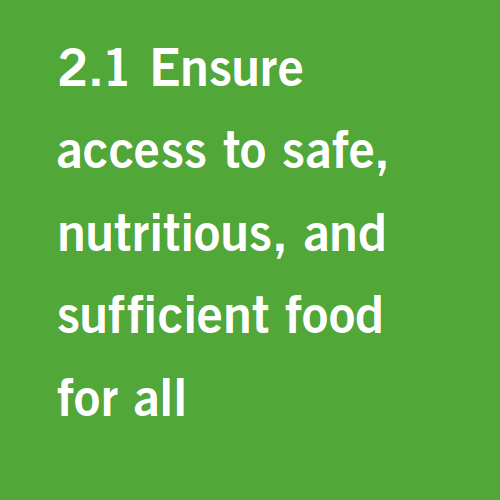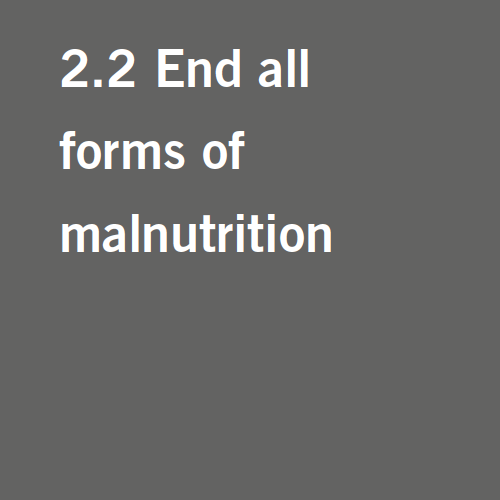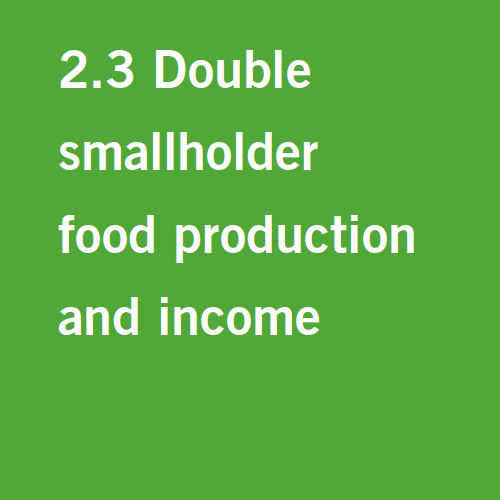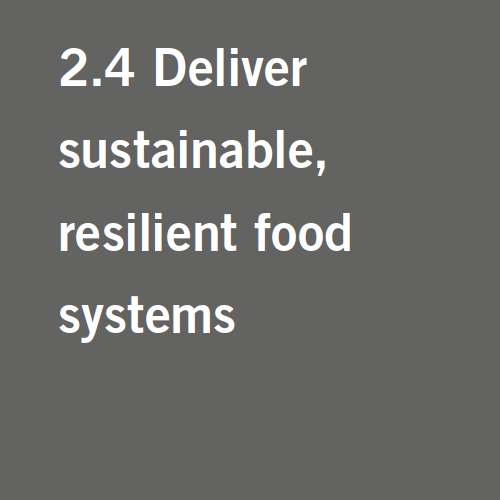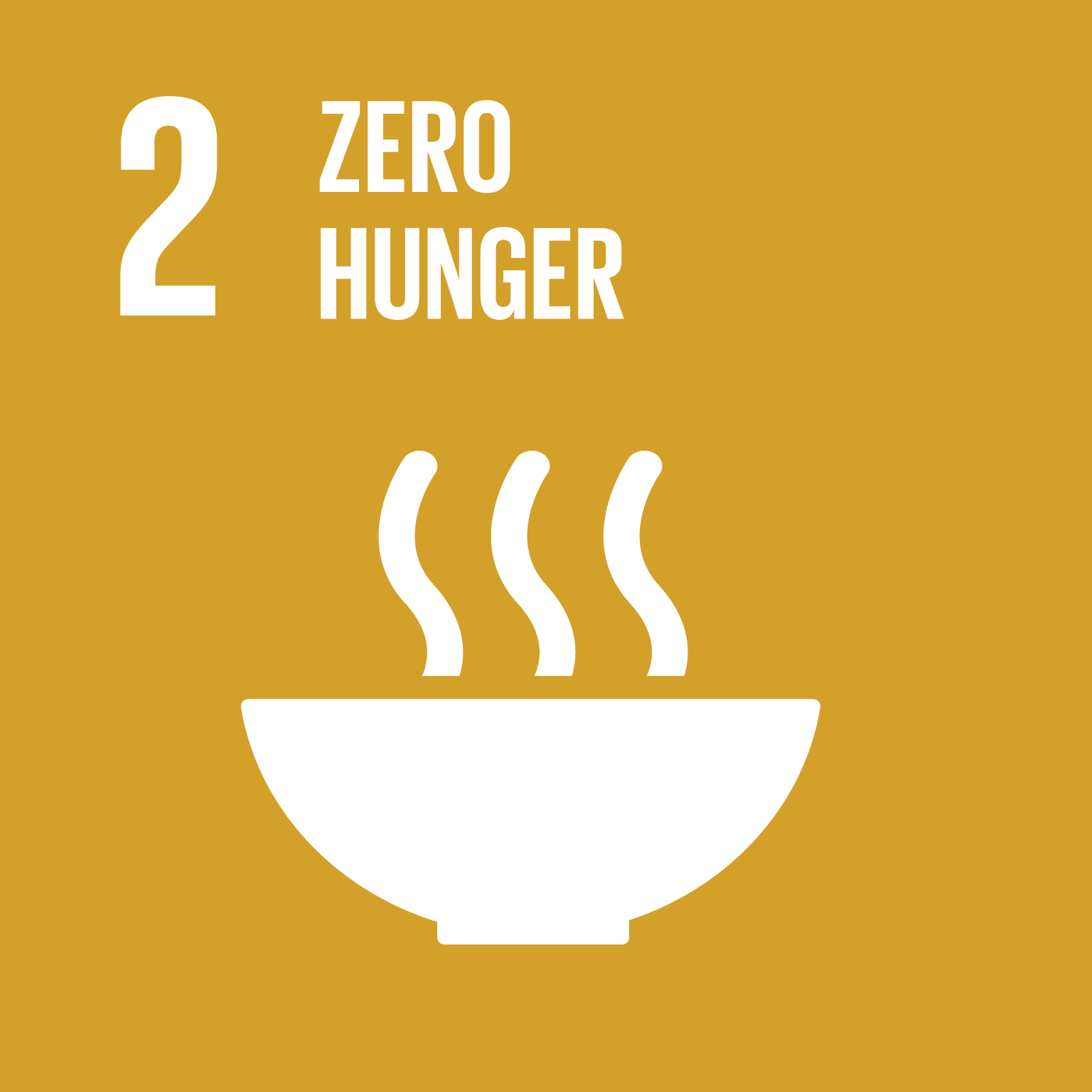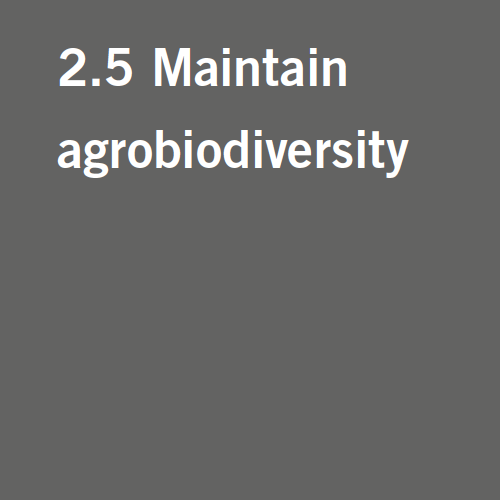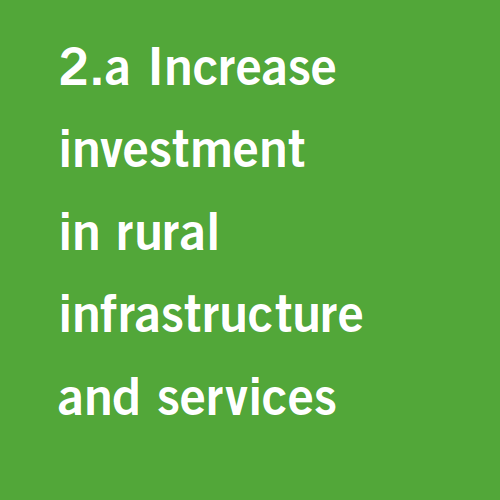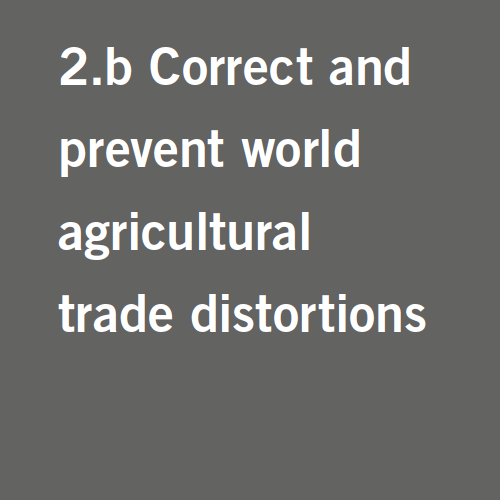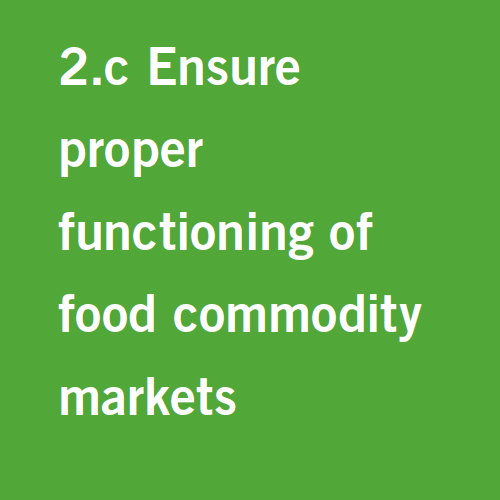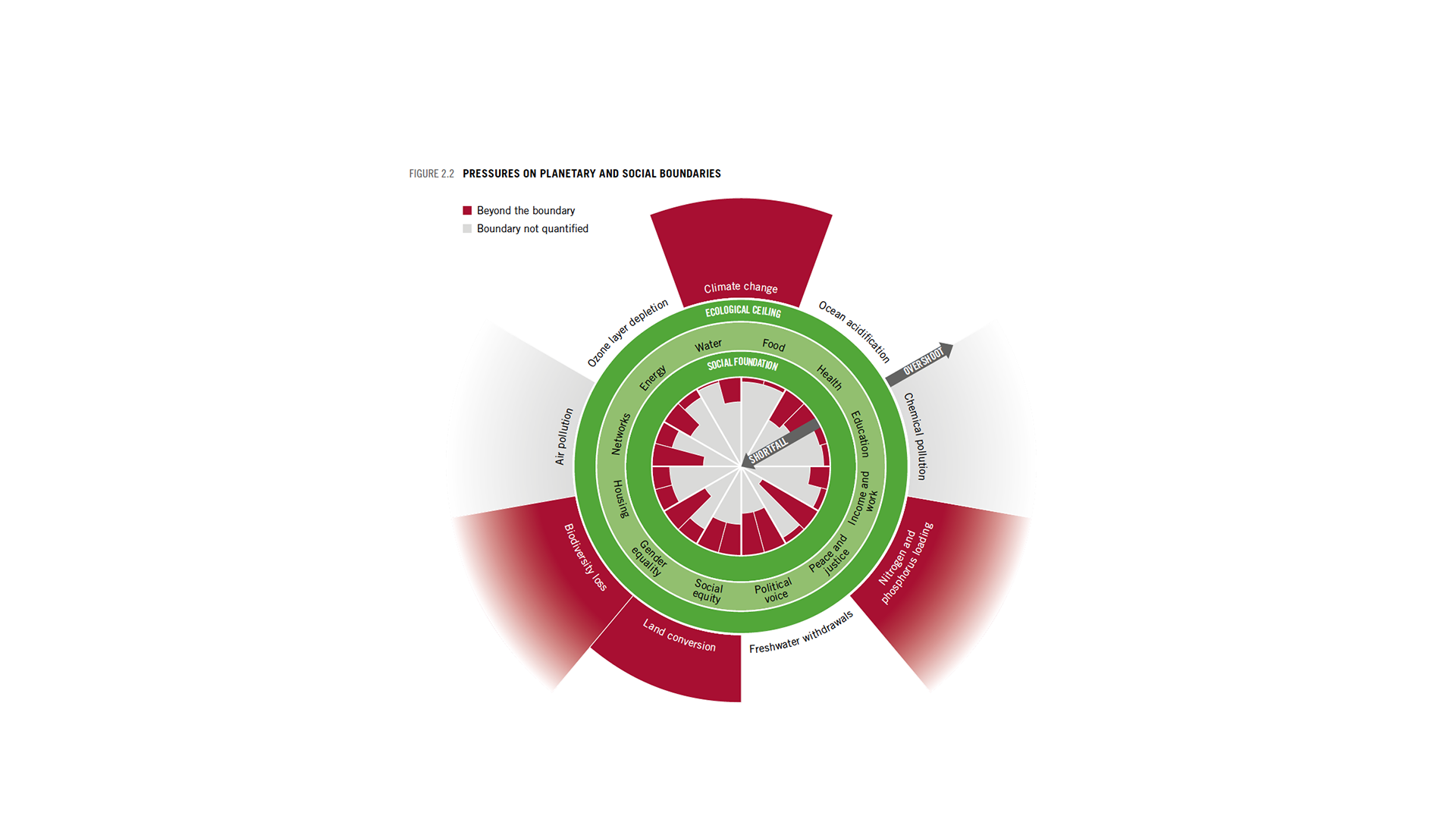One Health, Zero Hunger
Note: The views expressed in this chapter are those of the authors. They do not necessarily reflect the views of Welthungerhilfe or Concern Worldwide.
FIGURE 2.1 SUSTAINABLE DEVELOPMENT GOAL 2 (ZERO HUNGER) AND THE EIGHT TARGETS FOR ASSESSING PROGRESS
Source: Adapted by authors from UN (2020e).
2020.
It’s been a year that none of us could have predicted. Yet in many ways it is a culmination of the predictions we have heard for decades.
Warnings about the emergence of new viral pathogens are nothing new, but the failure to heed or act on those warnings has contributed to the scale of the COVID-19 pandemic and its effects.
At the same time, as predicted, humans’ impacts on the environment are leading to more frequent and severe extreme weather events, biodiversity loss, deforestation, and soil degradation. These impacts, when coupled with failure to invest in sound biosecurity practices, contribute to an increasing threat from emerging, boundary-crossing infectious diseases in humans, animals, and plants (Yadav, Singh, and Malik 2020; Royal Society and NAS 2020; Gray and Merzdorf 2019; Edwards 2017; Sundström et al. 2014; Seneviratne et al. 2012; Waage and Mumford 2008).
Cyclones have caused widespread damage in many South Pacific island countries and in South Asia in 2020, and heavy rains in usually dry regions have given rise to massive swarms of locusts that threaten crops in East Africa, South Asia, and the Gulf countries. The fall armyworm is decimating staple crops across Africa South of the Sahara and Southeast Asia, and control efforts are complicated by COVID-19 restrictions in many countries (Bourke and Sar 2020; FAO 2020f).
Unsurprisingly, the overlapping disasters of 2020 have led to economic and health-related hardships across the globe, hampering food security for millions by disrupting agricultural production, the availability of food, and people’s ability to obtain and utilize food, disproportionately harming those living in poverty.
The world was off track to reach Zero Hunger by 2030 even before each of the 2020 disasters exacerbated hunger and undernutrition.
Five years ago, the UN member states committed to 17 Sustainable Development Goals (SDGs), including SDG 2: “End hunger, achieve food security and improved nutrition, and promote sustainable agriculture” (see Figure 2.1). After a long, slow, progressive decline, the number of undernourished people started rising in 2015 and continues its upward trajectory. In 2019, even before the recent crises, nearly 690 million people suffered from chronic hunger, and 135 million people experienced acute food crisis. Child stunting and wasting are falling but not fast enough to meet SDG 2 (FAO et al. 2020; FSIN 2020; UN 2019b). Now the health and economic crises generated by the COVID-19 pandemic have resulted in income losses, food and labor shortages, and health service disruptions that affect the most vulnerable, threatening to set back progress even further. The World Food Programme warns that an additional 130 million people could be pushed into acute food crisis by the end of 2020, bringing the total to 265 million people (UN 2020f).
In the decade leading up to 2030, how can we overcome these shocks and setbacks to achieve Zero Hunger for all? The events of 2020 are laying bare many of the vulnerabilities of the world’s food system; they reveal that it is woefully inadequate for coping with the kinds of overlapping global and regional crises that we are currently experiencing and that we may expect more of by 2030 (FAO et al. 2020; Nguyen 2018). We have seen how the crises disrupt the food and agriculture sector, jeopardize the stability of human, animal, and environmental health, and have lasting implications on the global economy, livelihoods, and food security (FAO et al. 2020; OECD 2020). We argue in this essay that by taking an integrated approach to health and food and nutrition security, it is possible to achieve Zero Hunger by 2030. To do so, we must design responses to the current crises and their underlying causes and move forward in ways that support the transformation of the current food system to one that is more inclusive, sustainable, and resilient.
An important element of this endeavor will be to employ a holistic One Health approach. Sectoral responses alone rarely deliver sustained positive outcomes for complex problems such as climate change, chronic hunger, and unsustainable agricultural practices. One Health therefore works to achieve optimal health outcomes based on a recognition of the interconnections between humans, animals, plants, and their shared environment, as well as an understanding of the role of fair trade relations (CDC 2020; FAO 2020j). While the framing and use of the term “One Health” is relatively new, the concept is not: as far back as the 1800s scientists recognized the similarity in disease processes between animals and humans and coined the term “zoonoses” for diseases that can pass between animals and humans.
More recently, it has become clear that human impacts on planetary health, including land use change, soil depletion, greenhouse gas emissions, and biodiversity loss, are inextricably linked to animal and human health. To prevent, respond to, and recover from such challenges, cooperation among multidisciplinary teams is needed to safeguard agricultural production and public health from natural disasters and boundary-crossing diseases and to ensure that people have access to safe, nutritious, and healthy food. Currently, One Health tends to be implemented through consultation between sectors; it will become fully functional only when circular food, health, and economic systems - based on continual reuse of materials and products and elimination of waste - are implemented at local, national, and global levels (CHF 2020).
The One Health approach - with its focus on increasing sustainable practices in agriculture and improving the overall health and well-being of humans, animals, and the environment - has the potential to be transformative (Cleaveland et al. 2017; Garcia, Osburn, and Jay-Russell 2020; Alders et al. 2017; Lysaght et al. 2017). By highlighting the ways our current challenges are interconnected, One Health points to the need to tackle human, animal, and environmental health holistically in order to avert future health crises, restore a healthy planet, and sustainably end hunger.
Where the Cracks Are Showing: Weak Points in the World Food System
Figure 2.2
Pressures on Planetary and Social Boundaries
Source: A Doughnut for the Anthropocene: humanity’s compass in the 21st centuryNote: This schematic representation of social and planetary boundaries (also known as the Doughnut) illustrates the social foundation and ecological ceiling in the dark green circles, encompassing a safe and just space for humanity. The red wedges show overshoots of the ecological ceiling or shortfalls in the social foundation (some areas of the social foundation have more than one indicator, as shown by the red wedges; for a list, see Raworth 2017a). The extent of pressures on planetary boundaries that are not currently being overshot is not shown. The concept of planetary boundaries was first introduced by Rockström et al. (2009).
The COVID-19 pandemic has highlighted the fragility of globalized food systems, their inherent inequities, and their inadequacy to provide for healthy people and a healthy planet.
Our globalized food systems pose a threat to human, animal, and environmental health
We are hitting planetary and social boundaries—that is, the ecological ceiling and the social foundation beyond which humans cannot safely and equitably thrive—and our food systems are part of the problem (Figure 2.2; Raworth 2017b). Globally, we are seeking to achieve Zero Hunger at the same time that all societies are grappling with the need to manage the impacts of climate change, emerging diseases, extinctions and loss of bio- and agrodiversity, overconsumption of freshwater, rising rates of malnutrition, soil depletion and degradation, land use change, and biological and chemical pollution, while also meeting their immediate needs within national budgets (Alders et al. 2018; Rampa et al. 2019; also see Box 2.1 on the overlapping crises in the Horn of Africa).
One manifestation of the overshooting of planetary boundaries is the increasing frequency of the emergence of new infectious diseases and their rapid spread. As humans have encroached upon and destroyed natural habitats to establish, among other things, pastures for livestock, the result has been that wild animals live closer to areas where humans rear livestock and poultry, exposing domestic animals to a completely new range of pathogens and vectors to which they are highly susceptible. These diseases can spread rapidly, resulting in heavy morbidity and mortality among livestock, trade restrictions, and economic losses (Garcia, Osburn, and Jay-Russell 2020). Domesticated livestock and companion animals have been associated with increased risk of emerging infectious diseases (Johnson et al. 2020, Kock 2014), antimicrobial resistance (Graham et al. 2019), and introduction of disease into susceptible wildlife populations (Yadav, Singh, and Malik 2020). And the spread of COVID-19 shows the simultaneous vulnerability of public health, the economy, and food and nutrition security to emerging diseases.
Our food systems pose health hazards to humans and the environment and have a big part in the rise of emerging infectious diseases such as COVID-19. Through land use change, intensive agriculture, large-scale livestock production, and other practices, food systems have led to agroecological degradation, destroyed habitats, and contributed to climate change (IPES-Food 2017). Indeed, the food system contributes 21–37 percent of total net human-caused emissions of greenhouse gases and accounts for 70 percent of freshwater use. Agriculture—cropping and pasturage—occupies nearly 40 percent of global land (Willett et al. 2019; IPCC 2020).
Overall, the huge increase in intensive livestock production has been the most significant cause of the huge loss of biodiversity in recent decades; the extinction rate is now estimated at between 100 and 1,000 times that of preindustrial levels (Ceballos, Ehrlich, and Raven 2020; Ceballos et al. 2015; Pimm et al. 2014; Barnosky et al. 2011). Changing lifestyles and diets in recent decades have led to increased demand for animal-source foods such as eggs, meat, milk, and fish, resulting in higher rates of diet-related noncommunicable disease as well as in the intensification of production systems, overcrowding of animals, and increased risk of animal disease outbreaks and spillovers of disease from animals to humans (Yadav, Singh, and Malik 2020; FAO et al. 2020).
Half of the emerging zoonotic diseases between 1940 and 2005 have been attributed to changes in land use, agricultural practices, and food production (IPES-Food 2017). As land in low- and middle-income countries is converted to grow feed crops for cattle feedlots and intensively raised pigs and poultry in other parts of the world - sometimes as a result of land grabs by rich countries and corporations - the change in land use destroys forests and contributes to loss of carbon sinks (Blanco 2018).
Similarly, a significant part of the animal-source foods imported into low- and middle- income countries come from intensive livestock production in the exporting countries, with adverse impacts on global ecosystems, pastoralists’ livelihoods, and human health (Coordination SUD 2019). At the same time, domestic supply chains show weaknesses that threaten people’s food and nutrition security, including inadequate food preservation facilities for perishable foods such as fruits, vegetables, and animal-source foods (FAO 2017). Since the emergence of COVID-19, there has been an increasing focus on the human-animal-environment disease interface as encompassed in the One Health concept (Kock et al. 2020), with wet markets and their role in pathogen transmission from wildlife to people frequently cited (Restif 2020). However, wet markets have long played a key role in distributing fresh food in many societies and will continue to do so (Ribeiro et al. 2020). In a number of countries, consumers are concerned about a lack of access to affordable animal-source foods (owing to high animal mortality and market failure) and have little confidence in the safety of intensively produced food (Duggan 2015; World Bank 2016a); they worry, for example, about contamination of food with hormones, antibiotics, or pesticide residues. These concerns frequently underlie their preference for non-domesticated animals sold through informal markets (Alders 2020).
Our food systems are inherently unequal and further exacerbate inequities
Global food governance is tilted against low-income countries and smallholder farmers. The world’s increasingly globalized food systems have been accompanied by increasing dependence on food imports by low- and middle-income countries as well as underinvestment in local farmers, farmer associations, and smallholder-oriented value chains (FAO 2014, 2017; Poole and de Frece 2010; McMichael 2013). In 2017 the trade gaps between low- and middle-income countries on the one hand and high-income countries on the other were reported to be widening, with low- and middle-income countries projected to be net importers of meat and dairy products by 2030 (FAO 2017).
Most high-income countries provide international agricultural development assistance designed to help increase smallholder farmers’ production and income in low- and middle-income countries, while at the same time retaining trade advantages through non-tariff barriers to trade (Gourdon and Nicita 2012). Domestic production in low- and middle-income countries cannot compete with cheap imported goods (such as ultra-processed foods or powdered milk) that benefit from subsidized production in the country of origin (Blanco 2018).
Furthermore, some food assistance from high-income countries to low-income countries still requires the recipient country to procure food from a restricted number of countries or award contracts to companies in donor countries, thus weakening local food systems in recipient countries. A considerable share of global food assistance therefore remains an export subsidy masquerading as charity (OECD 2018). While the United Nations food agencies work in pursuit of food and nutrition security and sustainable agriculture, trade regulations discount the health impacts of trade in food commodities and can constrain low-income countries’ nutrition policies (Thow et al. 2017). At the same time, the globalization of food systems, along with persistent 19th-century approaches to food prices (that is, pricing based on weight or volume rather than nutrient composition and density) and the siloing of the agricultural, health, and environment sectors, places huge stresses on smallholder livestock keepers, small-scale aquaculture, and family farmers worldwide (Alders et al. 2016).
Given that family farms represent more than 90 percent of all farms globally and produce 80 percent of the world’s food in value terms, supporting these mostly smallholder farmers will be key to achieving SDG 2 (FAO and IFAD 2019).
Lack of secure land tenure and resulting food insecurity are a persistent issue for rural communities, indigenous people, women, and marginalized groups. Land grabs have a long history, from the colonial era to the present, and they continue to increase hunger and distort land management (Anderson et al. 2019). Displacement of smallholder farmers, pastoralists, and indigenous people is ongoing as international investors and corporations seize existing farmland and clear new land for agricultural endeavors across a range of countries (Twomey 2014). These land grabs are frequently driven by global capital and corporate agribusinesses that are responsible not to local land or people but to faraway shareholders (Deininger et al. 2011). A lack of enduring links to this land and its associated ecosystems contributes not only to a reluctance to employ sustainable practices requiring long-term investments in landscapes, including soil and water, but also to ecosystem damage resulting from the expansion of agricultural land into previously uncultivated landscapes, thereby increasing the risk of emergence of new pathogens (Anderson et al. 2019).
Insecure land tenure is a major contributor to degraded land and inadequate diets, the impacts of which are frequently felt more by women and marginalized groups (Alders et al. 2016). Women and other marginalized groups are disproportionately harmed by cultural and legal proscriptions and norms, including unequal access to credit and information, that prevent them from participating fully and equally in agricultural and other livelihood activities and from reaping the benefits of these activities (Alders et al. 2016; Quisumbing et al. 2014).
In Africa South of the Sahara, for example, women play a dominant role in the production, processing, and postharvest storage of food, yet they make up only 15 percent of landholders (Alders et al. 2016). When women have a lower income share within a household, that household spends less of its budget on food (Hopkins, Levin, and Haddad 1994). Widespread and ongoing iron deficiency in women of reproductive age, as well as a higher global malnutrition rate compared with men, reflects systemic discrimination, including within health and nutrition services (FAO et al. 2020; Alders 2018). The poor nutritional status of women interferes with their daily activities and livelihoods and crosses generations because poorly nourished women are more likely to give birth to children with a low birth weight (FAO et al. 2020). The 2020 GHI also shows that rural and indigenous regions often present higher rates of child stunting (see 2020 Results).
Formal and informal education on agriculture and nutrition is insufficiently tailored to local conditions. Individuals’ choices about their diets and farmers’ decisions about their agricultural practices are influenced by factors besides education, but without appropriate educational opportunities it is almost impossible to achieve optimal results, especially in resource-limited circumstances. A series of avoidable barriers mean that too many children lack access to the education necessary to learn life skills and help them thrive (UNICEF 2020b). Vulnerable households often cannot afford the costs associated with schooling or need children to supply farm or household labor (ILO 2020). School curricula are often poorly adapted to local circumstances, including local agroecological zones and marketing systems (Epstein and Yuthas 2012), and insufficient attention is given to understanding sustainable agriculture, human nutrition, and how to meet nutrient requirements with locally available, nutritious food (Garcia, Osburn, and Jay-Russell 2020; CHF 2020).
Social protection remains insufficient or misdirected. Support for the most vulnerable - that is, programs to boost the well-being of poor people, children, the elderly, and others through cash transfers, food transfers, subsidies, and social insurance - is crucial for people’s food security during crises, and the COVID-19 pandemic has highlighted the degree to which social protection is lacking. In many low- and middle-income countries, rural households increasingly rely on informal off-farm sources of income and are becoming net food consumers vulnerable to shocks (Rapsomanikis 2015).
Even before COVID-19, 55 percent of the world’s population was not covered by any social protection programs (Ortiz 2018). Carrying out such programs requires significant investment in avenues for connecting with individuals and households, especially those dependent on the informal sector (Razavi 2020). The lack of accurate data on the number of people involved in the informal sector and insufficient government and civil society links with informal networks increase the difficulty of organizing distribution programs. Furthermore, overseas remittances play a critical role in maintaining many households’ incomes and food consumption. Now, as a consequence of COVID-19 control measures, countless migrant workers worldwide are losing their jobs, and remittances to low- and middle-income countries are projected to fall by 19.7 percent to US$445 billion (World Bank 2020d). As unemployed migrant workers return to their home villages, they will place further strain on limited food stocks and social protection programs (Pancawati 2020). Finally, the agricultural and supply chain workers who feed the world receive low wages, have little to no job security (Martin 2016), and are frequently at high risk of contracting COVID-19.
Inadequate emergency responses are disrupting local food systems and fail to support local producers. COVID-19 containment measures, enforced without a clear declaration that agricultural and food services are essential, have endangered food security in many locations (Swinnen and McDermott 2020). Restricted labor mobility in areas dependent on seasonal or migrant laborers and the difficulties associated with accessing markets and transporting food both within and between countries are disrupting food supply chains and hampering people’s access to essential goods and services (FAO et al. 2020).
These restrictions not only cause short-term shocks to food supplies but also weaken local producers’ ability to prepare for the next sowing or production cycle, further diminishing the likelihood of achieving Zero Hunger in the coming decade (UN 2020d). This situation highlights the costly result of failure to coordinate preparedness and response activities between different sectors, such as health, agriculture, and trade.
Building Food Systems for One Health and Zero Hunger
We need to build back better by achieving inclusive, sustainable, and resilient food systems and preserving biodiversity for the future we want (UN 2020b, c). Working to achieve SDG2—Zero Hunger— and its associated targets by 2030 will be a crucial part of this rebuild, but what steps are required? Many immediate needs must be addressed now, and many others must be tackled over the coming decade. If we are to build back better, we will also need to undertake some transformations so monumental they will extend across the next several decades, as food systems and economies are reimagined as part of a net-zero-carbon world. As we pursue the goal of Zero Hunger, a One Health approach points the way toward a future that maximizes the health of humans, animals, and the environment. The following actions constitute a road map for ending hunger and building sustainable food systems now, over the next 10 years, and in the decades to come.
Actions for multilaterals, governments, communities, and individuals to take now
Sustain current food production and distribution. To guarantee ongoing food availability, the production and supply of food must be classified as essential services, and safe working environments must be guaranteed (FAO 2020i). Governments and citizens must also prepare now to ensure all required inputs are available for the next and subsequent planting seasons. As they bolster food supply chains and correct value chain disruptions associated with COVID-19 control measures, governments must work toward reduced food loss and waste in postharvest management and throughout the value chain. Aligning support for agricultural production by smallholder farmers, reducing food dumping, using cash and voucher assistance whenever feasible, and promoting the effective use of perishable food will require intersectoral coordination among governments, nongovernmental organizations, and community-based entities working collaboratively under a One Health banner (World Bank 2020b). Food and nutrition security projects linked with human, animal, and environmental health, such as those implemented by Vétérinaires Sans Frontières International, exemplify the multiple benefits of One Health programs that achieve greater integration of management, farming, food, and disease control aligned with local ecosystems (VSF Europa 2014). Equitable access to new technologies and emergency countermeasures, including diagnostics, vaccines, and therapeutics for both human and animal disease crises, as well as essential agricultural inputs such as appropriate seeds, must be guaranteed. In addition, governments should fully integrate their national security, health security, and food security strategies to develop sufficient preparedness and response capacity to address a wider array of potential hazards and threats to society.
Ensure governments, donors, and NGOs work closely with community organizations so that social protection measures reach the most vulnerable. Given that so many people affected by COVID-19 are informal workers, the unemployed, and the elderly, community-based and civil society organizations must help reach those unable to gain access to the official social protections on offer. Organizations trusted by communities and authorities are vital to ensuring that cash transfers, essential health care, food transfers, small business grants, and public employment schemes function optimally and fairly. In some areas hit hard by the economic consequences of the pandemic, households’ efforts to meet their food needs are threatening local ecosystems, biodiversity, and endangered species, so it is important to identify options for sustaining their food security in culturally acceptable ways that support human, animal, and planetary health (Poole 2020). In one past example in Chad, joint One Health efforts to combine childhood vaccination programs with cattle vaccination in pastoralist communities demonstrated both increased vaccination coverage and savings of 15 percent compared with the routine practice of separate campaigns for animal and human vaccination (Schelling et al. 2007). These types of innovative and practical One Health solutions, tailored to local needs and circumstances, will be required in a future constrained by the economic fallout of the COVID-19 pandemic.
Improve the coordination and efficiency of regional and international efforts. Regional institutions—especially regional economic communities such as the African Union and the Association of Southeast Asian Nations (ASEAN)—must negotiate strongly with donors and groups such as the World Trade Organization on behalf of low- and middle-income countries to shore up their own regional food supply chains and ensure access to the technologies, countermeasures, and expertise needed to respond to acute shocks like COVID-19 and the locust crisis. Key international agricultural programs should address the immediate crises and be replenished in accordance with evaluation findings, such as IFAD’s Scaling Up Evaluation Synthesis (IFAD 2017). Food assistance should also be designed to support local food systems in the recipient country. As part of this effort, all food assistance should be untied from the requirement to acquire donor-country commodities and from the continuing obligation to primarily use donor countries’ logistics, storage, and distribution companies, as recommended by the Development Assistance Committee (DAC) of the Organisation for Economic Co-operation and Development (OECD 2019). This would give recipient countries the flexibility to adopt best-value-for-money options for feeding their populations and implementing their food security strategies (Cardwell and Ghazalian 2020; Jaspars and Leather 2005). During the current crisis, governments and multilateral bodies must document and analyze the impacts of disruptions to international and national supply lines through a One Health and equity-sensitive lens to ensure efficient, equitable food production. The distribution of agricultural inputs, including credit and extension services, must not be subject to gender-based or other forms of discrimination. Finally, a number of key international summits are planned for 2021, including the Tokyo Nutrition for Growth Summit, the 26th United Nations Climate Change Conference (COP26), the 15th Conference of the Parties to the Convention on Biological Diversity, and the UN Food Systems Summit. The participants in these summits, as well as the global community, should ensure that the recommendations are well coordinated, coherent, and complementary; that they are actually implemented; and that they center on promoting the health of humans, animals, plants, and the planet. One example of what is possible when sectors, disciplines, and countries work together for the common good is the launch of the ASEAN Centre for Biodiversity in 2005, which has advanced the conservation and sustainable use of biological diversity, guided by fair and equitable sharing of benefits.
Actions for multilaterals, governments, communities, and individuals to take by 2030
Use lessons learned during the COVID-19 pandemic and other crises to build safe, resilient food systems that can prevent complex emergencies and better respond to them. Global agreements and action on sustainable food systems must bring all stakeholders to the table (FAO et al. 2020). To improve transparency and accountability, it is important to remove the friction between multilateral agencies, government ministries, and NGOs generated by overlapping mandates and competition for increasingly scarce resources. Huge trade and investment disparities between low- and middle-income countries and high-income countries perpetuate food system inequity and inefficiency, and these must be addressed. In response to shocks to food systems, high-income countries and the international community must address short-term symptoms (such as by providing food and cash or vouchers to vulnerable individuals and households and improving wet market facilities and hygiene standards) without harming the livelihoods of local food producers. Stakeholders must commit to dealing with the issues underlying chronic food and nutrition insecurity, loss of faith in food safety, and inadequate remuneration of farmers, producers, and other key participants within a resilient food system. They must significantly increase investments in agricultural research and development, food quality and safety, and human health, and they must ensure that domestic and international policy making, implementation, monitoring, and impact assessments are inclusive.
Carry out a global, multisectoral review of food, health, and economic systems through a One Health lens to chart a sustainable and resilient pathway for governments and donors that paves the way for environmental recovery. This review should be convened and implemented by a neutral entity with representatives from the public, private, and civil society sectors across all geographical regions. Among other things, it must address the need to strengthen data collection in order to better monitor the management of agricultural and natural resources on which smallholder food systems rely and to support the surveillance of animal, zoonotic, and foodborne diseases. Biosecurity legislation will need to take into account findings on crises such as COVID-19, the locust plague, fall army worm infestations, and African swine fever to enable the transparent trade of safe, high-quality food commodities and agricultural inputs that adhere to agreed-upon standards. Evidence on the impact of crises on low- and middle-income countries and on vulnerabilities in high-income countries, including evidence on how malnutrition increases health risks from pandemics, provides lessons that should be used to accelerate ongoing reforms, such as universal health coverage, global health security, and disaster risk reduction commitments. A new global coordination mechanism is required to enable food and other allied international thematic institutions to align policies in support of resilience and sustainable food systems (United Nations General Assembly 2019; UN 1992; WHO 2005; UNDRR 2015). These efforts must be accompanied by enhanced investments in sustainable food systems at the territorial level—including, where feasible, through properly regulated mechanisms blending public and private finance, such as public guarantees and responsible and just governance of tenure of land, fisheries, and forests (FAO 2012)—to reduce the investment risk associated with the food and agriculture sector.
Take a One Health approach to invest in sustainable food production, distribution, and nutrient recycling. Smallholders and input supply services must be provided with the knowledge and inputs to make their production systems more resilient and sufficiently profitable so they can meet their nutrient requirements either directly through their own production or indirectly through fair farm-gate prices that allow them to purchase safe and nutritious food (CHF 2020). Given the importance of diversifying both food production and consumption to achieve more sustainable and resilient food systems and better nutritional outcomes through sustainable healthy diets (Alders et al. 2016; FAO and WHO 2019), nutritious but neglected food species amenable to sustainable harvesting should be integrated into smallholder household livelihood strategies. A One Health approach that engages various sectors and disciplines will help identify options that enable households to use the food resources available to them across the seasons of the year and work with them to identify optimal practices (Wong et al. 2018). The reintroduction of river prawns upstream from the Diama Dam along the Senegal River is an example of this type of One Health approach in action. The project provides a regionally tailored, sustainable approach to the control of schistosomiasis—a disease that affects some 240 million people across the world—while enabling the restoration of a previously established source of food and income for local fisheries (Sokolow et al. 2015; Shaikh, Rahman- Shepherd, and Dar 2018). Governments and donors need to promote effective smallholder production and marketing organizations; cost-efficient food preservation, marketing, and food safety systems, including improved postharvest management; better linkages between rural and urban areas to shorten supply chains (increasing the resilience of local food systems to international shocks); agroecological approaches that match plant varieties, animal breeds, and farming systems with local conditions and tailored educational and vocational training (FAO 2020a); and efficient recycling of nutrient-rich organic waste (Alders et al. 2016). These activities must run in parallel with strengthened coordination across agriculture, education, finance, human health, and water, sanitation, and hygiene to generate synergistic outcomes, both horizontally and vertically. Evidence-based approaches to managing wet markets (including improved measures for preventing and controlling infection and disease surveillance systems) and options for effectively preserving animal-source foods, fruits, and vegetables are essential to support people’s access to and use of safe, nutritious, diverse foods. Finally, significantly reducing industrial livestock production while ensuring access for those who need animal-source food the most—undernourished pregnant and lactating mothers and infants in the first 1,000 days of life in resource-poor settings (Grace et al. 2018)—would offer clear gains: more competitive pricing of local products in low- and middle-income countries, recovery of the environment and biodiversity, mitigation of climate change drivers (Jackson et al. 2020; Young 2018), reduced global risk of emerging and persistent zoonotic diseases (Alders et al. 2013), and reduction of malnutrition (Grace et al. 2018).
Implement formal and informal education programs that match people’s circumstances. School curricula should be tailored to local conditions, including local agroecological zones and marketing systems. Students should be introduced to the One Health concept early on (Thomson 2020) and instructed in human nutrition and how to meet the nutrient requirements of girls, boys, women, and men with locally available, nutritious food to ensure good outcomes for human well-being, food and nutrition security, and natural resources (Garcia, Osburn, and Jay-Russell 2020; CHF 2020). In the Democratic Republic of the Congo, for example, farmer field schools and care group programs for women and children have been shown to be particularly effective.
Support regional trade initiatives that include social and environmental metrics. Trade agreements should do more than merely pursue short-term economic gains at the macro level. The 193 countries that signed the SDGs have committed to SDG 17.10: “a universal, rulesbased, open, non-discriminatory and equitable multilateral trading system under the World Trade Organization” (WTO 2020). These countries must push global agricultural, environmental, and trade institutions to deliver a harmonized policy framework that is good for food producers, consumers, the environment, and the economy.
Actions for multilaterals, governments, communities, and individuals to take beyond 2030
Globally and nationally affirm food and nutrition security as a key component of human health, as outlined in the 2019 United Nations Political Declaration on Universal Health Coverage. Acknowledging the key role of food and nutrition security will require balancing multilateral and national budget allocations across food-related sectors and harmonizing policies related to emergency response, agriculture, education, and health.
Develop and implement circular economic systems that promote sustainable local agricultural production along with climate-friendly and fair global trade of agricultural products and food. A circular economy recycles resources and materials to keep them continually in use, regenerates natural systems, and eliminates waste and pollution (CHF 2020). In a food system, a circular economy requires producers, consumers, companies, and governments to reduce the amount of waste generated in the food system, safely reuse leftover food, make use of by-products and food waste, recycle nutrients, and implement systems to manage food waste and surpluses so they are not lost to the system (Jurgilevich et al. 2016; Figure 2.3). The provision of affordable, fresh, healthy food is vital to ending malnutrition and improving well-being, making it essential for food producers and consumers to have more information about the larger systems in which they operate. Internationally based, locally adapted frameworks—developed collaboratively by governments, the private sector, and specialist civil society organizations—can inform these producers and consumers whether the landscapes that produce food are healthy and whether the food itself is becoming more or less nutritious. The key is to balance healthy and equitable food environments with just and sustainable remuneration of family farmers, fishers, and producers, enabling them to care for both their households and their land and aquatic environments (Alders et al. 2016). To achieve sustainable and equitable food systems, food must be valued not only by its weight or volume, but also by its nutrient density and freedom from biological and chemical contamination.
Conclusion: International Solidarity and Sustainable Values
We are likely to face more shocks and challenges on our way to 2030, even as we work to build a food system that can sustainably support a healthy, food-secure, well-nourished human population with Zero Hunger. The 2020 GHI findings highlight the food insecurity challenges facing low-income countries as they battle multiple crises. Right now, low- and middle-income countries can make progress by including marginalized groups in policy making, working together more effectively at the regional level to increase their negotiating power on the global stage, and ensuring shorter food supply chains within their regions. Both now and moving forward, they can carry out policies and programs that promote the well-being of female and male smallholder farmers and engage communities with agricultural production and food systems that are economically, socially, and environmentally sustainable.
We must not forget, however, that low- and middle-income countries cannot achieve the SDG 2 targets by 2030 without the full engagement of high-income countries. If Zero Hunger and the associated SDG 2 targets are to be met, high-income countries must also be active, positive contributors to dialogue and change. Among other things, they will need to use trade policy tools to create market incentives for sustainable food economies, untie aid and design food assistance to strengthen local and regional food systems, and change how agricultural products and services are valued so that nutrient content and ecosystem services are appropriately integrated into pricing mechanisms. A global transformation to a set of circular economies that feed all people through more sustainable food systems will not be completed by 2030, but by acting together we can achieve Zero Hunger while laying a solid foundation for a healthier, more sustainable, and more equitable world.
BOX 2.1
OVERLAPPING CRISES IN THE GREATER HORN OF AFRICA
Alliance2015
Many countries face overlapping health, hunger, and eco-nomic crises, but the challenges confronting the Greater Horn of Africa loom especially large. In a region already home to large numbers of people affected by chronic and acute hunger, the COVID-19 pandemic comes on top of a severe locust infestation, ongoing conflict and instability, a series of extreme weather events induced by climate change, and a history of massive forced displacement (see figures below). Measures to contain the pandemic have created negative social and eco-nomic effects, complicated treatment of the locust infestation, and pose an unprecedented challenge to food security and nutrition. If the responses to the diverse challenges are not carefully coordinated, a food crisis will loom large in the region.
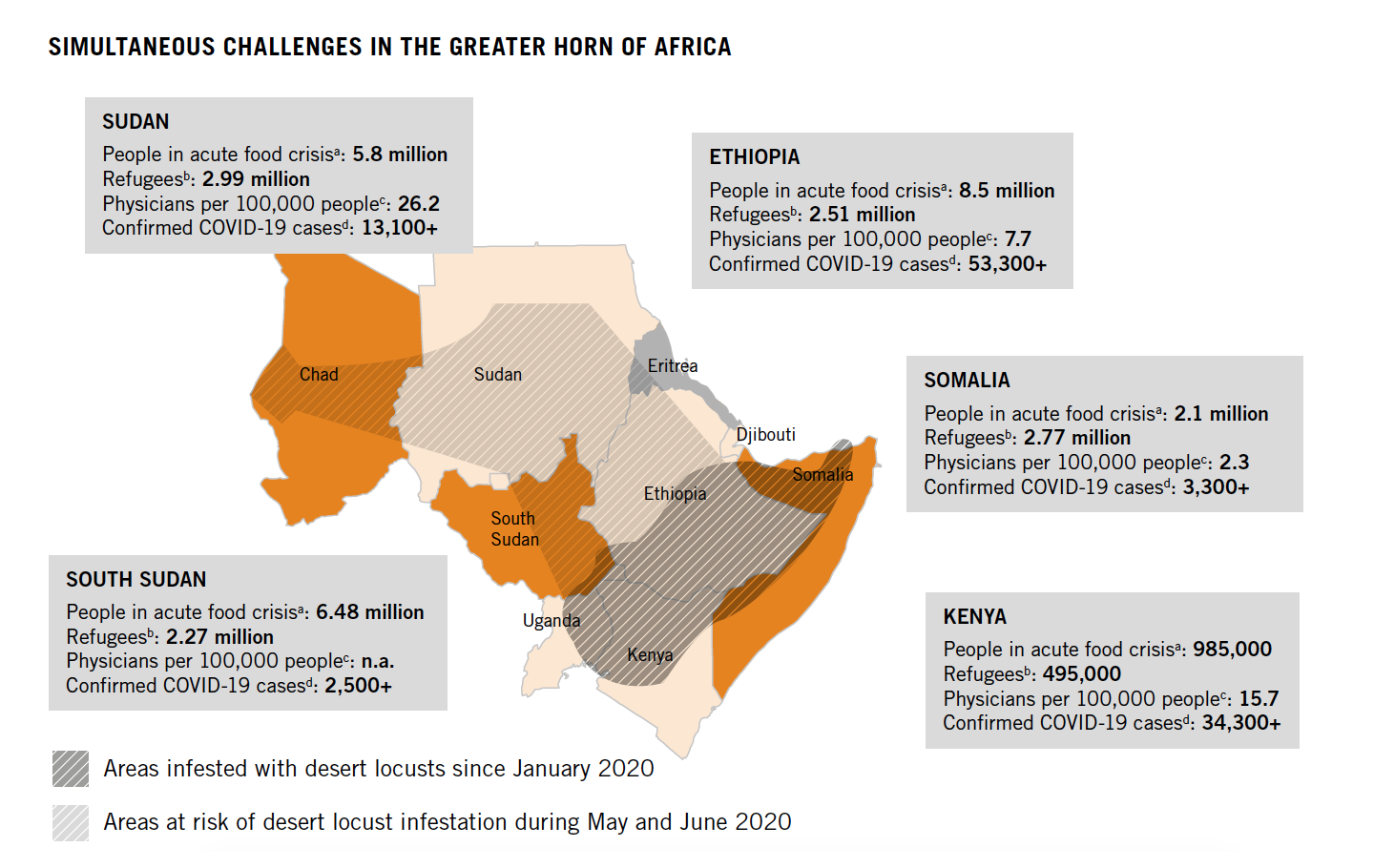
Source: Authors, based on IPC (2020), UNHCR (2020b), World Bank (2020e), and Johns Hopkins University and Medicine (2020).
Note: Colors of countries correspond to the GHI Severity Scale.
a People categorized as being in food crisis, emergency, or famine by the Integrated Food Security Phase Classification (IPC). Ethiopia: Feb–June 2020 projection;
Kenya: April–July 2020 projection, arid and semi-arid lands; Somalia: as of April–June 2020; South Sudan: May–July 2020 projection; Sudan: as of June–August 2019.
b Total number of refugees, asylum seekers, returnees, and internally displaced persons as of June 2020.
c For comparison, in 2017 the number of physicians per 100,000 averaged 80 in South Asia and 156.6 for the world as a whole.
d As of September 2, 2020.
Hunger is already widespread. For the past two decades, countries in the region have experienced serious, alarming, or extremely alarming GHI levels. In May 2020, more than 25.3 million people in the region faced acute food insecurity at crisis levels or worse. More than 11 million of these people live in areas infested by desert locusts, and their number is expected to grow as the locust swarm expands (IPC 2020).
The Horn of Africa commonly experiences severe droughts and floods, and extreme weather has contributed to the region’s worst infestation of desert locusts in decades. For the past nine rainy seasons, farmers and pastoralists in East Africa have experienced either severe flooding or scarce or failed rains, from which they are still recovering. All countries in the region are highly vulnerable to climate change but are ill prepared to deal with its effects (ND GAIN 2020; von Grebmer et al. 2019). As a result of two cyclones in 2018, heavy rains in the Arabian Peninsula generated a massive upsurge of desert locusts, exacerbated by another cyclone in late 2019. The swarms are destroying up to 100 percent of crops and fodder—a massive threat in a region where most of the population relies on agriculture. A swarm measuring one square kilometer can contain up to 80 million adult locusts, with the capacity to consume the same amount of food in one day as 35,000 people (FAO 2020k). As of April 2020, 200,000 hectares of cropland had been damaged and 356,000 metric tons of cereals had been lost in Ethiopia alone (FAO 2020l). Given that swarms can travel up to 150 kilometers a day, the risk is high that the locusts will spread not only across neighboring countries, but across the Indian Ocean to join the swarms already spreading in India and Pakistan (FAO 2020k, n).
Armed conflict, turbulent political transformation, widespread forced displacement, and poor governance have left many countries ill equipped to respond to crises. In Ethiopia and Somalia, a fragile political context and mistrust in the state prevail, and acceptance of COVID-19 containment measures is dwindling. The health and social protection systems in the region are largely unable to treat widespread diseases, such as tuberculosis, let alone respond to COVID-19 (Weber 2020). The region is home to more than 11 million refugees, asylum seekers, returnees, and internally displaced people (UNHCR 2020b). The Dadaab refugee complex, one of the largest such complexes in the world, lies in Eastern Kenya, near neighboring Somalia. In densely populated refugee camps and marginalized urban settlements, inadequate housing conditions and poor water and sanitation make it challenging for people to take preventive measures like hand-washing and physical distancing (Rudloff and Weber 2020).
The COVID-19 pandemic and measures designed to contain it are having severe social and economic effects that are worsening hunger and undernutrition. Like economies in other world regions, the already weak economies in the Greater Horn of Africa are likely to slip into recession. With limited medical capacity, countries in the region have relied heavily on border closures, travel restrictions, and strict lockdowns to flatten the infection curve. These measures, however, have hindered supply chains in the region, disrupting the availability of food in the markets as well as people’s ability to gain access to it. Restrictions have also hampered farmers’ access to agricultural inputs and their ability to cultivate their land (FAO and WFP 2020; IPC 2020). Urban residents who rely on the informal economy have been particularly hard hit, with market closures and restrictions on transport and mobility leaving them unable to generate income, to build up food reserves, or to provide for their families. Even rural populations that rely largely on subsistence farming are affected because they often buy some foods from markets (Rudloff and Weber 2020). Food prices were already high in some countries in the region, and poor harvests due to droughts and floods and COVID-19 countermeasures are aggravating the situation (FAO 2020m). A survey conducted in Addis Ababa in April 2020 showed that many households were already consuming more staple foods and fewer fruits and vegetables because more nutritious and balanced diets were unavailable and unaffordable (Hirvonen, Abate, and de Brauw 2020). Projections already warn that in the region more people could die from the socioeconomic impact of COVID-19 than from the virus itself (WFP 2020c).
This complex situation—an already fragile context combined with a severe locust infestation and COVID-19—could lead to a massive humanitarian crisis, and measures to cope with it must be planned holistically. An approach that focuses only on one crisis at a time may inadvertently exacerbate the other crises, which are all interlinked. Cross-border events require multilateral cooperation (such as between governments and with the Regional Desert Locust Alliance, FAO, and OCHA). Because the overlapping crises have different dynamics in urban and rural areas, they require distinct responses, but realities in urban and rural areas also influence each other and must be considered together.
TIMELINE OF NATURAL HAZARDS IN THE GREATER HORN OF AFRICA, 2018–2020

Footnotes
- “Food crisis” here refers to the crisis phase (phase 3), or worse, of the Integrated Food Security Phase Classification (IPC/CH) (FSIN 2020; IPC Global Partners 2019).
- See, for example, FAO et al. (2008); One Health Joint European Program (2020); and FAO (2020o).
- This affirmation should be in alignment with the all-hazards approach promoted by the Sendai Frame
